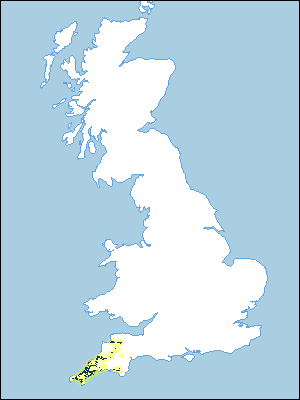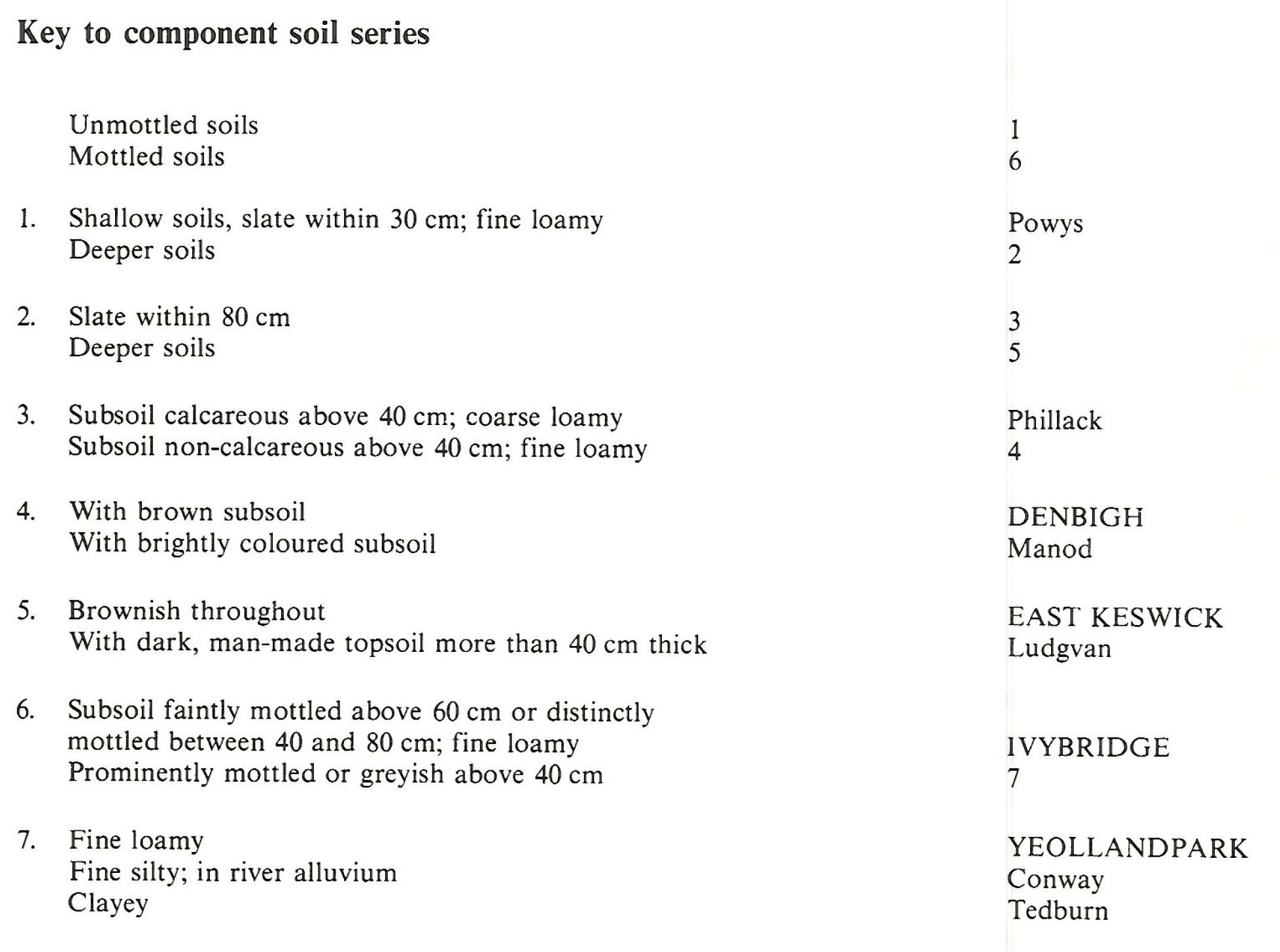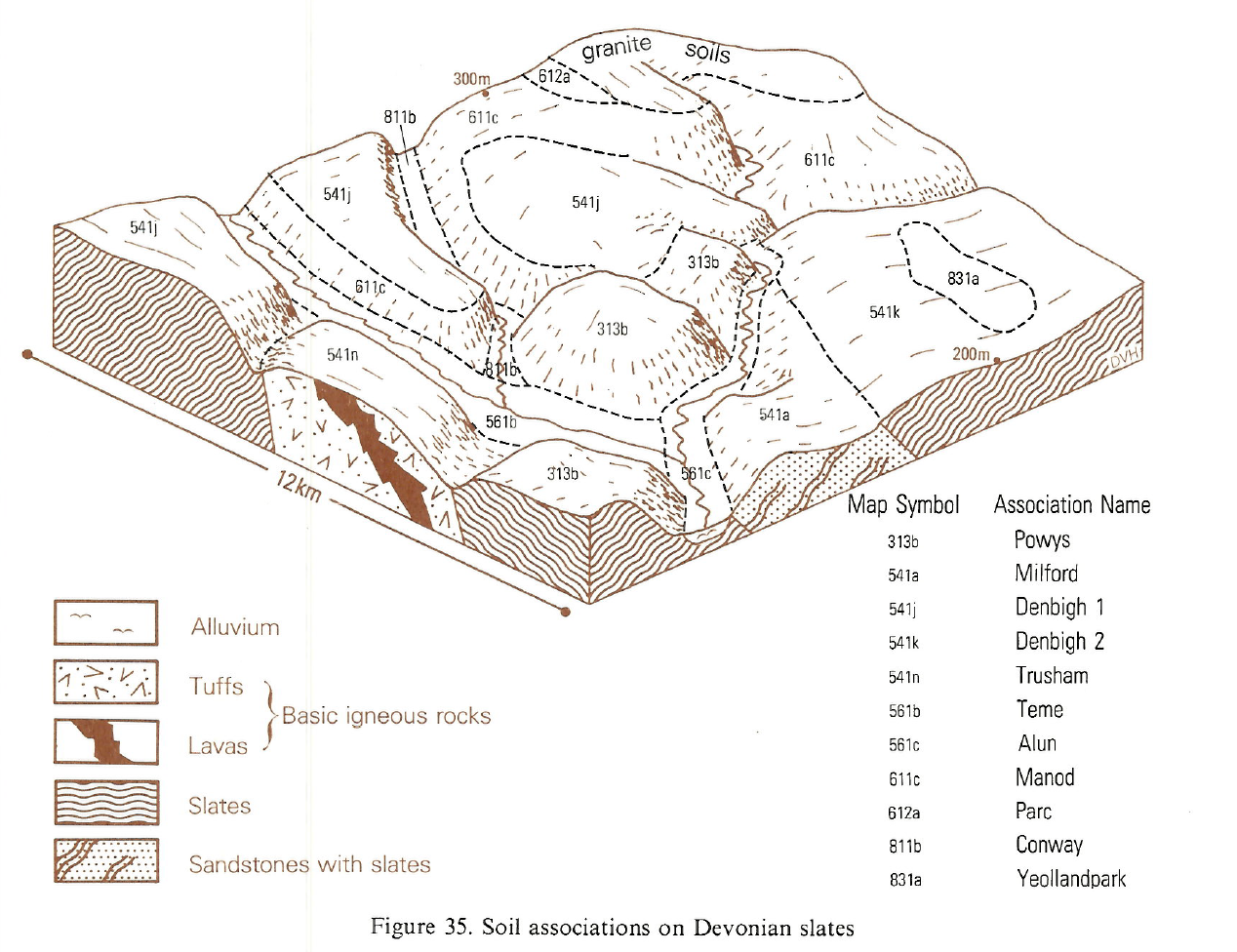
Soil Associations
0541k DENBIGH 2
Soil and site characteristics
Well drained fine loamy soils over slate or slate rubble. Some fine loamy soils variably affected by groundwater.
Geology
Palaeozoic slaty mudstone and siltstone
Cropping and Land Use
Dairying in lowlands with stock rearing on higher ground; cereals near coasts; early potatoes and broccoli in West Cornwall.
Component soil series
| Subgroup | Series name | Percentage | WRB 2006 link |
|---|---|---|---|
| 5.41 | DENBIGH | 40% | Eutric Endoleptic Cambisols |
| 5.41 | EAST KESWICK | 16% | Eutric Cambisols |
| 5.43 | IVYBRIDGE | 15% | Eutric Endogleyic Endoskeletic Cambisols |
| 8.31 | YEOLLANDPARK | 15% | Endoskeletic Mollic Gleysols |
Covers 1113 km2 in England and Wales
Soilscapes Classification
| 6 |
Freely draining slightly acid loamy soils |
0541k DENBIGH 2
Detailed Description
This association, of mainly fine loamy typical brown earths, is extensive in the gently undulating Devonian slate country of Cornwall and is found in Devon around Ivybridge and Bideford. Denbigh series are brown, permeable finely structured clay barns with slate or very stony layers within moderate depth. East Keswick soils are similar but deeper to rock. Fine loamy gleyic brown earths of the Ivybridge series and fine loamy typical cambic gley soils of the Yeollandpark series are both seasonally affected by groundwater in low-lying land. Yeollandpark soils are moderately permeable strongly mottled clay loams whereas Ivybridge soils are permeable brownish clay barns with mottling in the subsoil only. There are small inclusions of Tedburn, Conway, Powys, Trusham and Manod soils. Phillack and Ludgvan soils are found in Cornwall adjacent to dunes and where sea¬weed and sand has been added.
Stony well drained Powys soils occur on steep slopes and brows where rock is close to the surface, often accompanied by deeper Manod soils. In south Devon and south Cornwall some slates are locally more weathered to slowly permeable clay soils of the Tedburn series. Where rainfall is high, as in north Cornwall, permeable humic gley soils of the Freni and Hendraburnick series occupy broad depressions, usually in association with Yeollandpark soils. In south-east Cornwall on broad flat sites gleyed soils are rare and Denbigh soils are mostly replaced by deeper East Keswick soils. Patches of well drained loamy Trusham soils occupy small outcrops of basic igneous rocks within the slates.
In the lee of sand dunes along the north Cornish coast highly calcareous shell sand has blown onto slate-derived soils forming either coarse loamy calcareous brown earths of the Phillack series, or further inland Denbigh soils with calcareous and coarse loamy topsoils. In the Hayle district, long-term additions by farmers of beach sand, seaweed and other organic manures has produced highly-valued coarse loamy man-made soils of the Ludgvan series with thick dark topsoils and Denbigh soils with thinner, less modified, topsoils. Deep seasonally waterlogged silty clay barns of the Conway series are developed in the narrow strips of alluvium flooring many valleys. Coarser textured soils of the Alun series are found in the alluvium of rivers draining the granite outcrops. The climate varies considerably, though most land has an average annual rainfall between 1,000 and 1,300 mm. Near the south Cornish coast the rainfall is less than 1,000 mm but is over 1,600 mm at 300 m O.D. in north Cornwall. On low ground in west Cornwall and near the sea the warm winters give a very long growing season. Exposure to strong salt-laden winds can be severe close to coasts and wind exposure is a general problem at higher altitude.
Soil Water Regime
Denbigh and East Keswick soils are permeable and well drained (Wetness Class I). Water drains rapidly through these soils which quickly absorb excess winter rain. Ivybridge soils are occasionally waterlogged by groundwater (Wetness Class II). Yeollandpark soils are permeable but more strongly affected by groundwater (Wetness Class IV or III). Drought is only a major risk for grass on these soils where the rainfall is less than 1,200 mm annually. Cereal crops, and to a lesser extent potatoes suffer slightly from drought in some seasons. The deeper East Keswick soils have a larger available water capacity than Denbigh soils and crops grown on them rarely suffer from drought.
Cropping and Land Use
Denbigh and East Keswick soils are easily worked over a wide range of moisture contents but on Yeollandpark and, to a lesser extent, Ivybridge soils the timing of cultivations is restricted by soil wetness even after appropriate drainage measures have been taken. The land is mainly in grass. The intensity of use varies but dairying is the main enterprise, with stock rearing most important in districts with the highest rainfall. Poaching risk is related both to soil type and climate. Yeollandpark and Tedburn soils are at greatest risk. The long growing season overlaps in spring and autumn with the period when the soils are at or near field capacity so there is a temptation to graze the drier Denbigh and East Keswick soils well into the field capacity season, with resulting damage. There is a slight tendency to droughtiness in the shallower Denbigh soils but deeper soils are well suited to grass. Of the main soils only Yeollandpark series, when undrained, presents moderate limitations on grass use due to soil wetness. Arable cropping, mainly winter and spring barley, is mostly in the drier coastal districts on Denbigh and East Keswick soils. The favourable temperatures of west Cornwall allow the cultivation of early potatoes, winter brassicas and flowers, mostly on Ludgvan and man-modified Denbigh and East Keswick soils.
The soils are naturally acid and regular liming is necessary, especially where rainfall is high. In parts of west Cornwall, Phillack, Ludgvan and many Denbigh soils have a high topsoil pH as a result of liming, occasionally giving rise to trace element problems in stock. Extensive former mining activity in west Cornwall is responsible for large amounts of arsenic and other metals in soils close to abandoned workings, but associated trace element problems are not widespread. Regular phosphorus applications are often necessary on the main soils although the need for this depends upon past management. Forestry is generally unimportant although the few steep valley sides provide suitable sheltered sites. Although Yeollandpark and other wet soils are often improved by drainage, sites under mixed woodland or scrub in valleys provide much-needed havens for wildlife.
0541k DENBIGH 2
Distribution Map
 |
Note that the yellow shading represents a buffer to highlight the location of very small areas of the association.
Keys to component soil series
South Western Region
 |
Typical Landscapes
South Western Region
 |
All information Copyright, Cranfield University © 2024
Citation: To use information from this web resource in your work, please cite this as follows:
Cranfield University 2024. The Soils Guide. Available: www.landis.org.uk. Cranfield University, UK. Last accessed 20/04/2024
